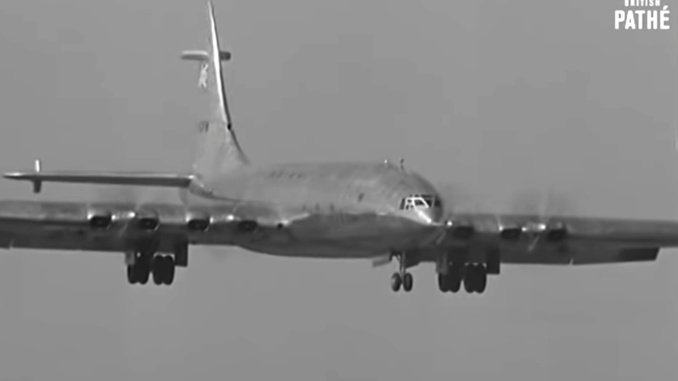
In 1943, Great Britian was already looking ahead to a post-war future. A committee was formed to study and report on the needs of civil and commercial aviation, headed by The Lord Brabazon of Tara, John Theodore Cuthbert Moore-Brabazon, Member of Parliament. He’d served in the Royal Flying Corps (which became the Royal Air Force, April 1918) with distinction during the First World War. From 1940-1941 he’d been Minister of Transport and from 1941-1942 he was Minister of Aircraft Production.
By agreement early in the Second World War, Great Britain concentrated on building mostly fighter and bomber aircraft, while the United States would build large numbers of transport aircraft: enough to fill both American and British war needs. Realizing this would leave them at a disadvantage after the war in terms of civil and commercial aircraft production capability, the government sought to reverse that situation at the earliest possible time. Lord Brabazon’s committee report recommended development of four aircraft: a short-range, a mid-range, a long-range, and a fast jet airliner.
The long-range type was to be designed as a luxury trans-atlantic giant that would compete directly with ocean liners. It would carry enough fuel to fly non-stop from London to New York, so there would be no delays stopping to refuel in Greenland, Iceland, or Ireland, as transports of the early ’40s did. It would have advanced features such as fully-hydraulic flight controls, electric controls for engine functions, and low-drag fuel saving aerodynamics.
Perhaps foreseeing that post-war Britian and Europe would not have large numbers of people who could afford to travel by air, the Brabazon committee envisioned the market for the trans-atlantic airliner as consisting only of the very wealthy and government officials who needed to get to their destinations faster. To attract wealthy passengers who ordinarily would have booked passage on an ocean liner, the accomodations were equally luxurious. The pressurized double-decker cabin was a spacious 25 feet in diameter – absolutely huge at that time. Inside were roomy seats for up to 150 passengers, or sleeping berths for 80 customers. There would be lounges, a bar, and possibly a movie cinema. The idea, again, was to compete with the comfort and luxury offered by an ocean liner, but able to get to the destination in a fraction of the time.
Bristol Aeroplane Company had experience building medium and large bombers during the war. In 1946, they designed the new long-range trans-atlantic airliner, which they called the Bristol Brabazon, based on a large bomber design they had proposed in the war years. It would be as big as a 747, with a longer wingspan. There were eight radial engines (four pairs) embedded within the massive wings for more efficient aerodynamics. Each engine pair turned counter-rotating propellers through a gearbox mounted directly behind the props, theoretically making for a quieter cabin experience. Test pilots raved about how easy it was to fly, how well it handled in the air and on the ground.
In the end, no airline company wanted to buy the Bristol Brabazon. The committee who intially conceived it had prepared it to face the main competition of 1939: ocean liners. For the market realities of 1949, it carried too few passengers for it’s size, making it impossible for an airline to turn a profit. Yet, if the interior had been redesigned to double the number of passengers (which the aircraft could have easily done) there just wasn’t enough demand from the post-war public. The economy hadn’t recovered from the war yet, and wouldn’t for at least another ten years. It was too big for the market it was born into. Turbo-props and jet engines were on the horizon, further challenging the big plane economically. On the other hand, the Brabazon was far ahead if it’s time with technological features that wouldn’t be common in airliners until the 1960s. It was simultaneously ten years ahead of and behind its time.
The Brabazon was a beautiful machine and one of the first modern passenger aircraft. More pictures and background details can be found online.
Question of the Night: How important is luxury and comfort to you when you travel?
